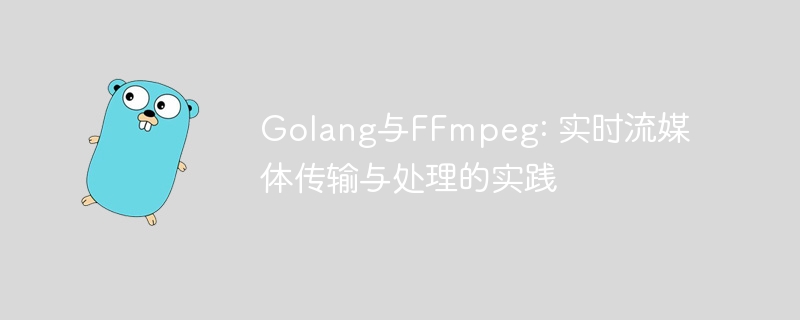Home >Backend Development >Golang >Golang and FFmpeg: The practice of real-time streaming media transmission and processing
Golang and FFmpeg: The practice of real-time streaming media transmission and processing
- 王林Original
- 2023-09-28 09:51:421493browse

Golang and FFmpeg: The practice of real-time streaming media transmission and processing
Introduction:
With the development of the Internet and digital technology, streaming media has become our life an integral part of. Whether it is webcasting, video conferencing or online education, streaming technology plays an important role. In the process of real-time streaming media transmission and processing, Golang and FFmpeg have become the preferred tools for developers. This article will introduce the combined use of Golang and FFmpeg to help readers better understand how to implement real-time streaming media transmission and processing, and provide specific code examples.
1. Introduction to Golang:
Golang (also known as Go language) is a programming language developed by Google. Its goal is to provide a programming language with fast compilation, high concurrency and intuitive syntax. programming language. Golang was originally designed to solve some pain points in large-scale software development, such as building efficient and reliable network services and processing large-scale data. Golang has become the choice of many developers through its concise syntax, powerful standard library and rich development tools.
2. Introduction to FFmpeg:
FFmpeg is an open source multimedia processing tool that can handle a variety of audio, video and picture formats. FFmpeg provides a wealth of function libraries and command line tools, allowing developers to easily perform operations such as audio and video transcoding, editing and processing. Thanks to its powerful and flexible features, FFmpeg has become the de facto standard in streaming media processing. Whether it is a live broadcast platform, video compression or media player, FFmpeg plays an important role.
3. Combination use of Golang and FFmpeg:
Golang provides a binding library for FFmpeg, allowing us to simply use FFmpeg in Golang. By combining the concurrency of Golang and the power of FFmpeg, we can achieve real-time streaming and processing.
First, we need to install FFmpeg and the corresponding Golang binding library. They can be installed by executing the corresponding installation command on the command line. After the installation is complete, we can start writing Golang code.
The following is a simple example that shows how to use Golang and FFmpeg to implement the function of streaming video to a remote server and processing it.
package main
import (
"log"
"os/exec"
)
func main() {
// 创建命令行参数
cmdArgs := []string{
"-i", "input.mp4",
"-c:v", "h264",
"-b:v", "2048k",
"-f", "mpegts",
"udp://127.0.0.1:1234",
}
// 创建FFmpeg命令
cmd := exec.Command("ffmpeg", cmdArgs...)
// 执行命令并等待完成
err := cmd.Run()
if err != nil {
log.Fatalf("执行FFmpeg命令失败:%s", err)
}
log.Println("完成实时流传输")
// 执行后续处理任务(例如保存文件、转码等)
// ...
}In the above example, we created a FFmpeg command and specified parameters such as input file, video encoding format, bitrate, and output format. We then use Golang’s exec package to execute the command. After the command execution is completed, we can continue to perform subsequent processing tasks.
The above example is just a simple demonstration, and actual applications may involve more parameters and processing tasks. By studying the usage documentation of FFmpeg and related libraries of Golang, we can achieve more in-depth implementation of real-time streaming media transmission and processing.
Conclusion:
The combined use of Golang and FFmpeg provides a convenient solution for real-time streaming transmission and processing. By leveraging Golang's high concurrency and FFmpeg's powerful features, we are able to achieve efficient and stable streaming applications. We hope that the relevant code examples provided in this article can help readers better understand how to use Golang and FFmpeg to implement real-time streaming media transmission and processing. In practical applications, we can carry out more functional expansion and optimization according to needs. Now, give it a try!
The above is the detailed content of Golang and FFmpeg: The practice of real-time streaming media transmission and processing. For more information, please follow other related articles on the PHP Chinese website!

